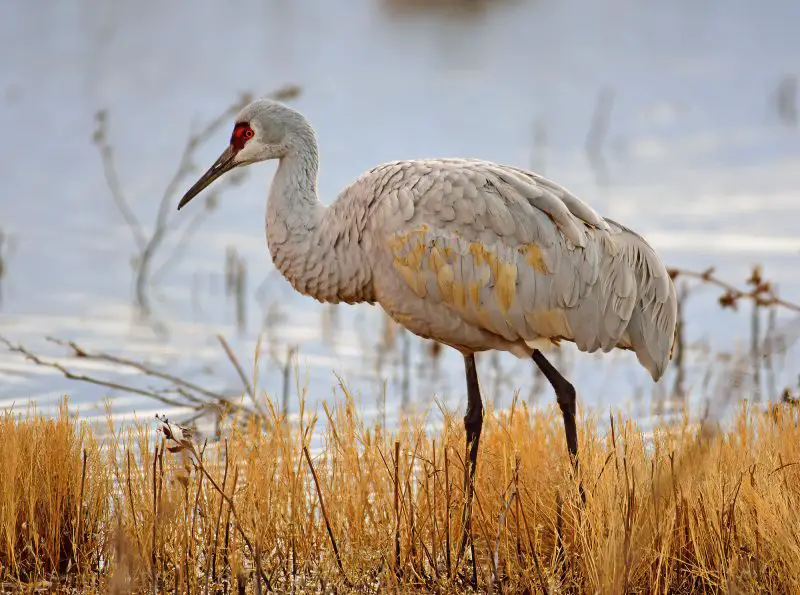In Louisiana, only two crane species are regularly recorded: the Whooping Crane and the Sandhill Crane. While one is an endangered conservation icon, the other is a seasonal visitor that gathers in impressive flocks during winter. Both species play important ecological roles and have unique behaviors that make them worth studying.
This article provides a comprehensive guide to the two types of cranes in Louisiana. You will learn about their characteristics, identification, size, feeding habits, habitats, breeding, distribution, and even some fascinating fun facts.
By the end, you will not only be able to identify these birds in the field but also appreciate the conservation efforts that protect them.
Whooping Crane (Grus americana)

Characteristics and Identification
The Whooping Crane is the tallest bird in North America, reaching about 5 feet in height with a wingspan stretching up to 8 feet. Its striking white plumage, accented with black wingtips visible in flight, makes it unmistakable. The head features a vivid red crown and a black mustache-like facial marking that helps distinguish it from other large wading birds like herons or egrets. When flying, Whooping Cranes extend their necks straight forward and their legs behind them, giving them a streamlined silhouette.
Juveniles, however, are slightly trickier to identify because they are not fully white. They display a patchwork of cinnamon-brown and white feathers until they molt into adult plumage at about a year old. Their loud bugling call can carry for miles across wetlands, serving as both a territorial announcement and a contact call between pairs.
Size and Physical Features
Whooping Cranes stand around 5 feet tall, with males slightly larger than females. They weigh between 14 and 17 pounds, making them one of the heaviest flying birds in North America. Their long, dagger-like bill is well adapted for probing the ground and capturing prey. The black tips of their primary feathers are only visible when the bird takes flight, a crucial identification feature when comparing them to the similar but gray-colored Sandhill Crane.
Behavior and Daily Life
Whooping Cranes are known for their stately movements and elaborate courtship displays. During mating season, they perform synchronized dances, which include wing flapping, bowing, and leaping into the air. These dances strengthen pair bonds and communicate readiness to breed. Whooping Cranes are monogamous, often staying with the same partner for life. They are also highly territorial, defending nesting areas vigorously from intruders.
Feeding Habits and Diet
As omnivores, Whooping Cranes have a varied diet. In Louisiana, they forage in marshes, wetlands, and agricultural fields. Their menu includes insects, crayfish, frogs, small fish, snakes, and even small mammals. They also consume plant material such as seeds, tubers, and grains. Seasonal availability of food strongly influences their diet, with aquatic prey dominating in wetter months and agricultural grains becoming more important in drier conditions.
Habitat and Distribution in Louisiana
Historically, Whooping Cranes were widespread across North America, but their population plummeted to just 15 individuals in the 1940s. In Louisiana, they disappeared entirely by the 1950s due to hunting and habitat destruction. A reintroduction program began in 2011 at the White Lake Wetlands Conservation Area, located in Vermilion Parish. Today, Louisiana supports a growing non-migratory population of Whooping Cranes. Sightings are most frequent in the southwest region of the state, including Acadia, Avoyelles, Calcasieu, Cameron, Jefferson Davis, and Rapides parishes.
Breeding and Nesting
Whooping Cranes breed in wetlands with shallow water, which provides both food and protection from predators. They build large nests out of plant material, often anchored in standing water. The female typically lays two eggs, though usually only one chick survives due to sibling rivalry or limited resources. Both parents participate in incubating the eggs and feeding the young. In Louisiana, successful nesting and fledging of wild-born chicks is an encouraging sign of the reintroduction program’s success.
Conservation Status
The Whooping Crane is classified as endangered under the U.S. Endangered Species Act. Although conservation efforts have increased the population to several hundred individuals, they remain vulnerable to habitat loss, human disturbance, and illegal shootings. In Louisiana, education campaigns and legal enforcement aim to protect these birds from harm. The state has seen gradual population growth, with over 80 individuals recorded by 2023.
Fun Facts about Whooping Cranes
Whooping Cranes get their name from their loud, resonant “whoop” calls, which can travel for miles across wetlands and open landscapes. These unique calls are not just for communication but also play a vital role in pair bonding and territory defense.
They are also among the longest-lived birds in North America, with some individuals surviving more than 30 years in the wild. This longevity makes them symbols of resilience, especially considering their near-extinction in the 20th century and their gradual recovery today.
One of the most fascinating behaviors of Whooping Cranes is their elaborate courtship dance. These displays involve leaps, wing flaps, and graceful bows, and pairs often continue this ritual throughout their lifetime, strengthening their lifelong bond.
Despite their tall stature and heavy build, Whooping Cranes are powerful fliers. During migration, they can soar on thermal currents and cover hundreds of miles in a single day, showcasing their strength and endurance in the skies.
Sandhill Crane (Antigone canadensis)

Characteristics and Identification
The Sandhill Crane is a tall, gray bird, reaching about 4 feet in height with a wingspan of up to 6.5 feet. Unlike the all-white Whooping Crane, Sandhill Cranes have gray plumage that sometimes appears rusty due to iron-rich mud staining their feathers. Their most distinctive feature is the red patch of bare skin on the forehead and crown, contrasting sharply with their otherwise gray coloration. They also have a white cheek patch that helps in identification.
When flying, Sandhill Cranes extend their necks straight forward and their legs behind them, similar to Whooping Cranes. However, their smaller size and uniform gray color help differentiate them. Their calls are loud, rolling trumpets that are often described as a rattling bugle, carrying across great distances.
Size and Physical Features
Sandhill Cranes typically weigh between 7 and 10 pounds, significantly lighter than Whooping Cranes. Their wingspan measures around 6 to 6.5 feet, and their height ranges from 3.5 to 4 feet. They are slender birds with long, thin legs adapted for wading in wetlands. Juveniles have a more uniform rusty-brown plumage before they mature into the classic gray coloration.
Behavior and Daily Life
Sandhill Cranes are highly social birds, often seen in flocks numbering from dozens to thousands, especially during migration and winter. Like Whooping Cranes, they engage in spectacular dances involving leaps, wing spreads, and bows, which serve both courtship and social bonding purposes. They are strong fliers and often migrate in V-shaped flocks, calling loudly as they pass overhead.
Feeding Habits and Diet
Sandhill Cranes are opportunistic feeders, consuming a wide range of foods depending on availability. Their diet includes seeds, grains, berries, and tubers, as well as insects, amphibians, and small mammals. In Louisiana, they are often seen foraging in harvested agricultural fields, where they feed on leftover corn, rice, and other grains. Their long bills allow them to dig into soil for roots and tubers.
Habitat and Distribution in Louisiana
Unlike the non-migratory Whooping Cranes, Sandhill Cranes appear in Louisiana only during winter months. They typically arrive in November and remain until early March. Their preferred habitats include open wetlands, prairies, and agricultural fields. Large flocks can be seen in places like Holmwood in Cameron Parish and Cheneyville in Rapides Parish. These areas provide both abundant food and safe resting grounds.
Breeding and Nesting
Sandhill Cranes do not typically breed in Louisiana, as the state serves mainly as a wintering ground. Breeding takes place farther north in Canada and the northern United States. Their nests are built on the ground in marshes or grasslands, often near water. Like Whooping Cranes, Sandhill Cranes usually lay two eggs, with both parents sharing incubation duties. The chicks are precocial, meaning they leave the nest within a day and follow their parents as they forage.
Conservation Status
The Sandhill Crane is considered least concern by the International Union for Conservation of Nature (IUCN). Their population is stable and even increasing in some areas. However, habitat loss and hunting remain potential threats. In Louisiana, they are not permanent residents but form an important part of the state’s winter bird diversity. Birdwatchers from across the region often visit known hotspots to observe their massive flocks.
Fun Facts about Sandhill Cranes
Sandhill Cranes are among the most ancient living bird species, with a fossil record dating back at least 2.5 million years. Their long evolutionary history makes them a fascinating link to prehistoric times.
These majestic birds can live for 20 years or more in the wild, demonstrating remarkable longevity and adaptability across a variety of habitats.
One of their most distinctive features is their loud, resonant bugling calls. These sounds are amplified by an unusually long windpipe that coils down into the sternum, allowing their calls to carry for miles across open landscapes.
During migration, Sandhill Cranes are impressive travelers. They can cover up to 400 miles in a single day, often flying in large, organized flocks that create striking V-shaped formations in the sky.
Comparing the Two Cranes of Louisiana
While both species share many similarities as large, long-legged, long-necked birds, there are clear differences that help in identification:
Feature |
Whooping Crane |
Sandhill Crane |
|---|---|---|
Plumage |
Entirely white with black wingtips |
Gray, often with a rusty hue |
Size |
Larger, around 5 feet tall |
Smaller, around 4 feet tall |
Range in Louisiana |
Year-round residents due to reintroduction |
Winter visitors |
Conservation Status |
Endangered and rare |
Common and widespread |
Observation Notes |
Spotting one is rare and treasured |
Gather in large numbers during winter, creating a spectacular sight |
For birdwatchers in Louisiana, spotting a Whooping Crane is a rare and treasured event, while Sandhill Cranes provide an annual spectacle as they gather in large numbers during winter.
Final Thoughts
Louisiana is home to only two crane species, but they could not be more different in their conservation stories. The Whooping Crane, once lost to the state, is making a remarkable comeback thanks to dedicated reintroduction efforts. Its presence symbolizes hope for endangered species recovery and the impact of focused conservation programs.
On the other hand, the Sandhill Crane remains a common and widespread species, offering birdwatchers a spectacular annual display as large flocks gather during winter. Together, these two cranes highlight the diversity and ecological richness of Louisiana’s wetlands, reminding us of the delicate balance between rarity and abundance in the natural world.
FAQs about Cranes in Louisiana
What types of cranes can be found in Louisiana?
Louisiana is home to two crane species: the Whooping Crane (Grus americana) and the Sandhill Crane (Antigone canadensis). While the Whooping Crane is rare and primarily present due to reintroduction programs, Sandhill Cranes are common, especially during the winter months.
When is the best time to see cranes in Louisiana?
Sandhill Cranes are most easily observed in winter, from late November through February, when they gather in large flocks across the state’s wetlands. Whooping Cranes can be seen year-round, but spotting one is rare and often requires visiting protected areas or wildlife refuges.
Where can I see Whooping Cranes in Louisiana?
The best locations to observe Whooping Cranes include protected wetlands such as the Rockefeller Wildlife Refuge and the Cameron Parish areas. These sites are part of reintroduction programs designed to support the species’ recovery.
Where can I see Sandhill Cranes in Louisiana?
Sandhill Cranes are widely seen in agricultural fields, marshes, and open wetlands during winter. Wildlife refuges and public wetlands across the state provide excellent viewing opportunities as flocks congregate for feeding and roosting.
What do cranes eat in Louisiana?
Both Whooping and Sandhill Cranes are omnivorous. Their diet includes grains, seeds, insects, small vertebrates, and aquatic plants. During migration or winter, Sandhill Cranes often feed in agricultural fields on leftover grains.
Are Whooping Cranes endangered?
Yes, Whooping Cranes are classified as endangered. Intensive conservation and reintroduction efforts in Louisiana and other states have helped increase their numbers, but they remain rare and closely monitored.
How can birdwatchers safely observe cranes?
To protect these sensitive birds, maintain a respectful distance using binoculars or spotting scopes, avoid disturbing nesting or roosting areas, and follow guidelines provided by wildlife refuges. Observing cranes quietly enhances the experience without threatening their safety.






